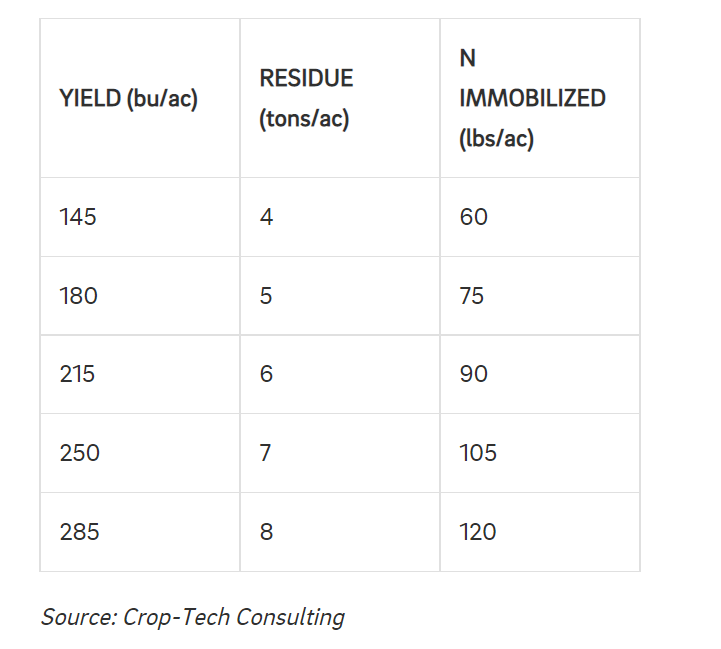Ferrie: Beware the Carbon Penalty in Cornfields Now

Many corn crops emerged in the past week and are off to a strong start. Now is a good time to evaluate the impact of the carbon penalty in fields and determine your next steps, advises Ken Ferrie, Farm Journal Field Agronomist and owner of Crop-Tech Consulting, Heyworth, Ill.
How The Carbon Penalty Works
What happens is as your soils warm up, microbial organisms in the field go to work decomposing last year’s corn stalks and residue. The organisms consume a lot of nitrogen (N) to do their job.

“When soil temperatures get above 65 degrees F, the micro-organism population in the residue starts to explode. With every 10-degree temperature increase in the soils, the population doubles, and this explosion sucks up nitrogen, phosphorus and sulfur,” Ferrie explains.
The carbon penalty can happen to any size of corn plant, in any production practice. However, corn grown in high-residue situations – such as in corn-on-corn fields or fields with cover crops – is most at risk.
Ferrie adds he is concerned that farmers who transitioned to variable rate fertilizer applications this year – or applied the bulk of their N last fall – could pay a larger penalty this season than usual because they had inadequate N levels in fields to begin with.
"In your nitrogen management program, you have to address timing and placement, as well as the amount,” he explains. "You’ve got to have the nutrients at the right place at the right time for the crop."
Look For Ugly Corn
Ferrie’s team pulls nitrate samples at both 1-foot and 2-foot depth intervals in the field every week to track the carbon penalty. It’s a process they have used from spring thaw to fall freeze up for decades.
In fields where the carbon penalty is underway, he says you will start to see plants turning lighter green or yellow.
“This will be especially true for some of the April-planted corn that is no longer living off of seed reserves and is getting ready to hand off to the corn roots at between V3 and V5,” he says.
“If anything has messed with the development of those crown roots, this handoff doesn't go very well,” Ferrie adds. “We're talking compaction, wheel tracks, sidewall smearing, and herbicide issues – they're all going to become visible in the stunted plants. They can be just as green as the rest of the field but stunted,” he adds. “The plants will be at the same collar as neighboring plants but not as uniform.”
Ugly corn will look better over time, because the bigger plants will outgrow the stunted plants.
“But it will delay pollination, and it does have an effect on ear size,” Ferrie says.
Your Corn Crop Might Need More N
Both the carbon penalty and ugly corn syndrome can be managed around.
Fertility is key to getting corn to come out of the carbon penalty and go on to produce a good crop.
“It’s worth the cost of extra nitrogen when you look at today's corn prices,” he says. “You don’t want to get caught with your corn turning yellow and staying yellow, because when the crop runs out of energy, it’s game over.”
Soybeans can also be caught in a carbon penalty, which can cause growth to stall at around V3. Like in corn, the soybean will often turn shades of yellow. However, Ferrie says he has not seen a yield drag because of the carbon penalty.
Soybeans will make their own nitrogen starting at around V4 or V5.
Look For Cutworms, Tweak Threshold Numbers
Ferrie says cutworms are actively working in many fields in central Illinois. He says the “old” threshold for spraying was 3% cut plants. With current corn prices, he advises farmers to go to a 1.5% threshold.
“These critters are easy to kill, so don’t let them mess with these stands,” he advises.
Ferrie notes that the “big flights” for this pest occurred in central Illinois from April 22 through May 2 this year.
“Think back on any field that had vegetation then or after that date, that field will need to be watched. Corn planted in cover crops will also need to be watched closely. This includes those of you who used henbit and chickweed as your cover crop,” he adds, jokingly.
You May Get Just One Fungicide Application. Line It Up Now
Where Could Corn and Soybean Prices Be this Fall?
You can listen to this week’s complete Boots In The Field podcast here:







